In adapting to complex and ever-changing ecological environments, animals must continuously receive and process a variety of sensory inputs, storing and integrating them to ultimately produce appropriate behavioral responses. This ability to process information and make behavioral decisions reflects the level of intelligence in animals. Among the key determinants of animal intelligence are the capacity to process information—especially sequential information—and memory persistence. In the fields of cognitive neuroscience and animal behavior, the concepts of the sequence bottleneck and memory traces are regarded as important mechanisms influencing animal intelligence, shedding light on both the potential limits of animal cognition and the dynamic processes of information storage.
The concept of the sequence bottleneck has emerged in recent years to explain the uniqueness of human evolution in language and higher cognitive abilities. For instance, in visual tracking tasks, animals struggle to attend simultaneously to multiple dynamic targets [1] , whereas humans can accomplish this. In these animals, the difficulty in visual tracking tasks exemplifies the sequence bottleneck. Consider that parrots can mimic human speech and marine mammals communicate through sound; yet, why have they not developed language or culture comparable to that of humans? Similarly, if monkeys and humans share a common ancestor, why have modern monkeys not evolved into humans?
One perspective holds that non-human species, even with extensive training, find it challenging to complete complex sequential discrimination tasks, whereas humans can master these tasks with minimal practice—a difference that may be attributed to the unique human ability to encode and decode sequences of information. Recently, Johan Lind from Linköping University in Sweden and Anna Jon-And from Stockholm University published an article exploring the uniqueness of human cognition and the limitations of animal intelligence. Their work, which centers on the concept of the sequence bottleneck, integrates insights from language evolution, neural mechanisms, higher cognition, and animal intelligence [2] . They examined the cognitive differences between humans and other species—particularly with regard to sequential memory and discrimination abilities—and found that the human brain’s exceptional capacity to encode and process sequential information underpins our unique cognitive profile.
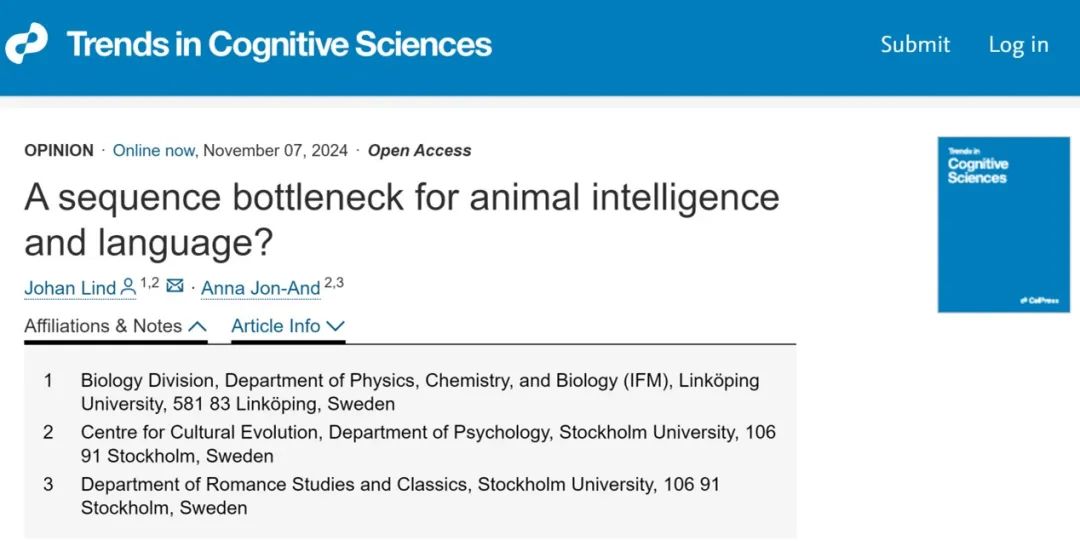
▷ Lind J, Jon-And A. A sequence bottleneck for animal intelligence and language?. Trends Cogn Sci. Published online November 7, 2024. doi:10.1016/j.tics.2024.10.009

Sequence Bottleneck and Biological Evolution
Research on primates, birds, and mammals has revealed significant differences in their performance in sequential learning. Certain birds (such as parrots) are capable of mimicking complex sounds; however, quantitative experimental measurements have shown that they lack the ability to convert these sounds into grammatical language. Similarly, although dolphins can transmit information through vocal patterns, these signals do not exhibit grammatical structure. Moreover, while orangutans and chimpanzees can express their needs through gestures and sounds, they too struggle to combine these elements into more complex messages.
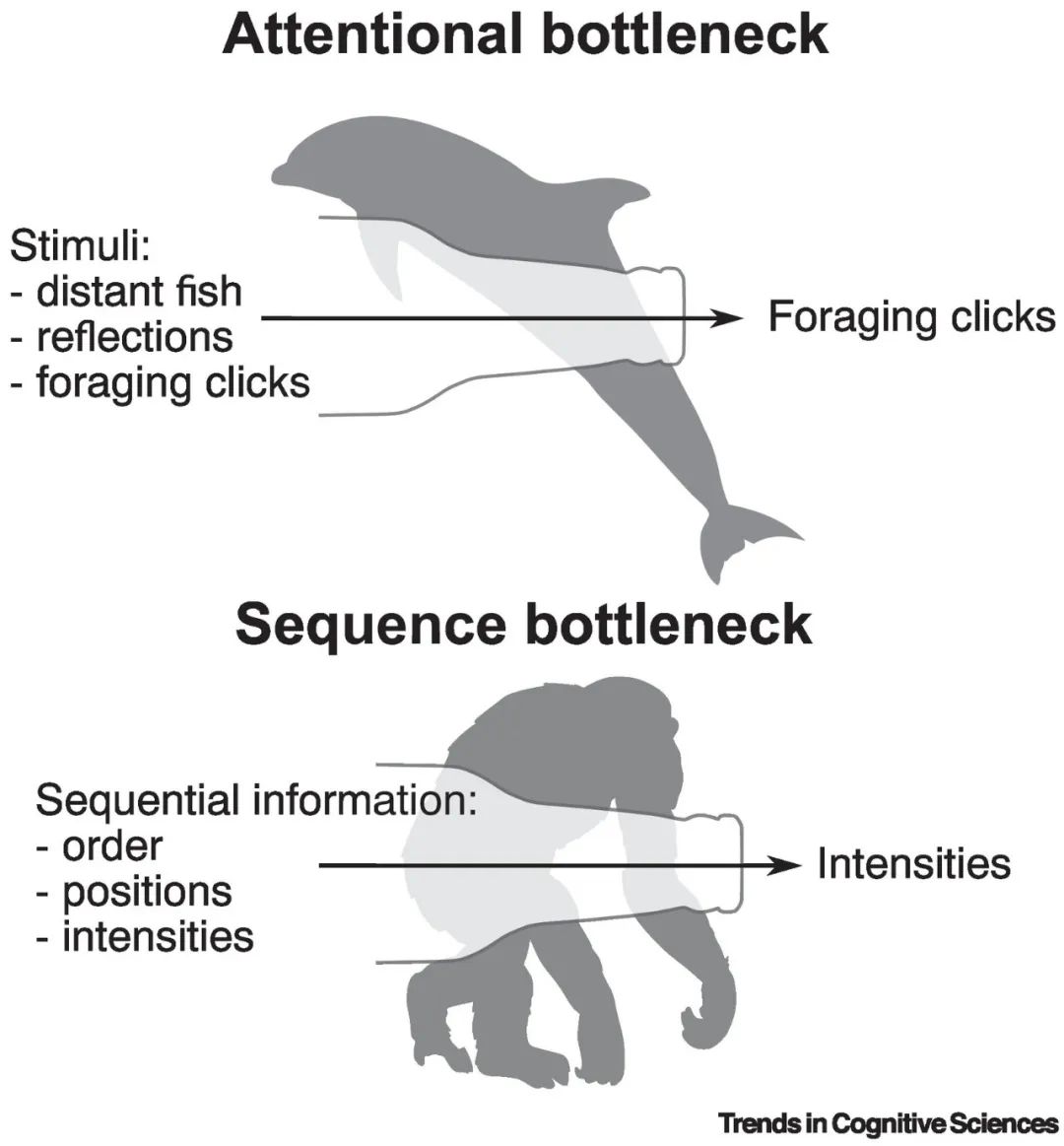
▷ 图2. The attention bottleneck in dolphins and the sequence bottleneck in apes. Source: [2]
The emergence of language and higher intelligence in primates appears to be somewhat accidental. Through language, we can exchange ideas, record history, share experiences, and create complex cultures. Yet, why is it that only humans have developed complex linguistic abilities over billions of years of biological evolution? Why have other species struggled to overcome their cognitive limitations (i.e., the sequence bottleneck)?
From the perspective of neural mechanisms, several notable differences exist between human neural networks and those of other animals:
-
Neuronal density: The density of neurons in the human cerebral cortex is significantly higher than that found in other primates.
-
Clear functional partitioning: Language-related areas, such as Broca’s and Wernicke’s areas, are highly developed in the human brain [1].
-
Synaptic plasticity: Neuronal synapses in the human brain exhibit greater plasticity, which facilitates the learning and retention of complex information.
Of course, these unique advantages come at corresponding costs. Firstly, in terms of energy consumption, the human brain accounts for 20% of the body’s total energy expenditure—a figure far exceeding that of other species. Secondly, humans experience a prolonged developmental period (neoteny), providing ample time for the development of language and cognitive abilities.
The capacity for advanced sequential processing depends on the coordinated function of the prefrontal cortex and other brain regions, and the evolution of such structures requires a substantial energy investment. During evolution, organisms must first secure their basic survival needs (such as foraging and reproduction); consequently, this survival priority may have suppressed the emergence or evolution of energy-intensive cognitive abilities. Conversely, complex sequence processing requires memory, attention, and predictive capacities—higher functions that depend on a sufficiently intricate neural system . Only higher-order animals have evolved such complex neural architectures, and these systems, in turn, may limit the evolution of advanced sequential abilities.
Thus, the ability to process complex sequences is constrained by multiple factors—including neural mechanisms and energy metabolism—and only a very limited number of species have been able to overcome this bottleneck.
Moreover, the foundation of language and higher cognitive functions lies in the ability to process complex sequences. Linguistic sequences can be divided into two types: linear sequences, in which words are arranged in a specific order to form sentences, and hierarchical sequences, in which sentence structures involve nested relationships—such as the use of main and subordinate clauses, modifiers, the overall grammatical architecture, and even higher-level narrative expressions. The ability to process complex sequences is central to language.
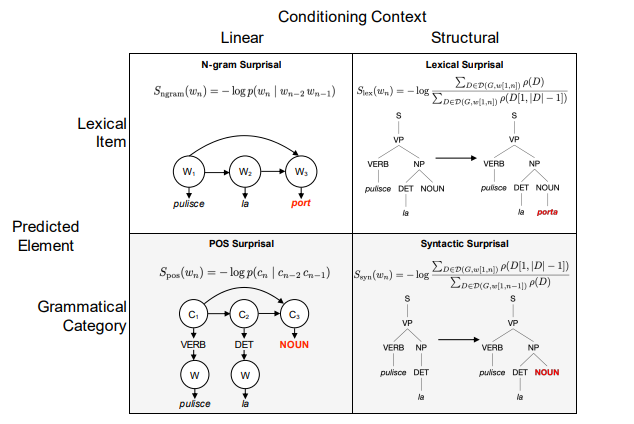
▷ Linguistic Sequences. Source: Greco, Matteo & Cometa, Andrea & Artoni, Fiorenzo & Frank, Robert & Moro, Andrea. (2023). False perspectives on human language: why statistics needs linguistics. 10.48550/arXiv.2302.08822.
In addition to the sequence bottleneck, memory traces are frequently regarded as an important mechanism affecting animal intelligence. Memory traces refer to the information stored in an individual’s neural system following an event, which in turn influences subsequent behavior and learning abilities [3].
The interaction between the sequence bottleneck and memory traces is particularly evident in animal intelligence. On one hand, the sequence bottleneck may affect the formation and retrieval of memory traces—for example, when an animal processes too much information in a short period, the accuracy of its memory traces may decline. On the other hand, the existence of memory traces can help alleviate the impact of the sequence bottleneck. In foraging tasks, for instance, memory traces enable animals to rely less on real-time information.
Animal intelligence manifests differently from human intelligence. Although animals face limitations in sequential processing, they can exhibit unique abilities within their respective domains. For example, crows can use tools to solve complex problems; in social learning, apes and dolphins can acquire new behaviors by observing their peers; and in terms of spatial memory, certain birds can remember hundreds of locations where food is hidden. These evolutionary adaptations in animal intelligence are often closely tied to survival needs. Foraging strategies and the complex behaviors associated with them require a certain level of cognitive ability, and the capacity to predict predator behavior to evade capture enhances survival rates.
Furthermore, social interactions and complex group structures have promoted the evolution of social behaviors. Scientists have employed machine learning techniques to analyze the vocal data of animals, using algorithms to identify distinct acoustic patterns and even attempting to decode the “languages” of species such as whales and birds. Research indicates that most animals are capable of processing only simple linear sequences and are unable to comprehend more complex sequences. The primary reason for this limitation is the constraint of short-term memory (i.e., memory traces)—animals generally have a limited working memory capacity, making it difficult to store multi-layered information.
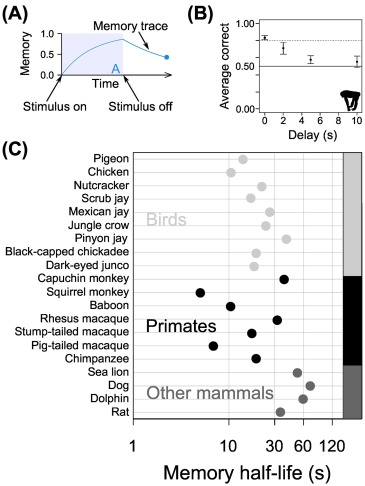
▷ Animal Memory Traces. Source: [2]
Compared to humans, animals exhibit relatively limited learning capabilities and are less able to adapt quickly to changing environments. Lacking a language system, animals are unable to establish systematic and abstract modes of expression. Consequently, they cannot accumulate and disseminate knowledge within their groups.

Language is the Highest-Level Sequence Bottleneck
Human language is unique in its combinatorial, symbolic, and sequential forms. The transition from a world without language to one with language is extremely challenging. The sequence bottleneck can partly explain why other species have not evolved language. Of course, the millions of years of human evolution cannot be replicated, nor are the conditions necessarily applicable to other species. Nevertheless, the ability to decode complex sequential information is essential for the emergence and refinement of language, which in turn has greatly advanced human intelligence and collaborative capabilities.
Language is not merely a tool for communication; it is a central component of human cognition. It enables the transmission of experiences and skills across generations, laying the foundation for cultural and technological advancement. By providing a symbolic system, language allows us to express complex abstract concepts and logical relationships. Language and intelligence have co-evolved, a process that reinforces the human advantage in processing sequences. Enhanced cognitive abilities have led to increasingly complex linguistic structures and more diversified modes of expression.
The sophisticated neural networks in the human brain underpin language development, and language use further promotes brain development. The human prefrontal cortex and its associated neural circuits play a critical role in both sequential processing and complex cognitive functions, serving as a central hub for these operations. The prefrontal cortex is responsible for planning, decision-making, and impulse control, thereby forming the foundation for complex thought. Its synergistic interaction with the hippocampus facilitates the storage and processing of lengthy sentences and intricate structures. In contrast, animals typically have smaller brain volumes and relatively simpler neural architectures, with circuits that are less capable of processing temporal information. This disparity in neural mechanisms is a fundamental reason behind the unique presence of language and advanced intelligence in humans.
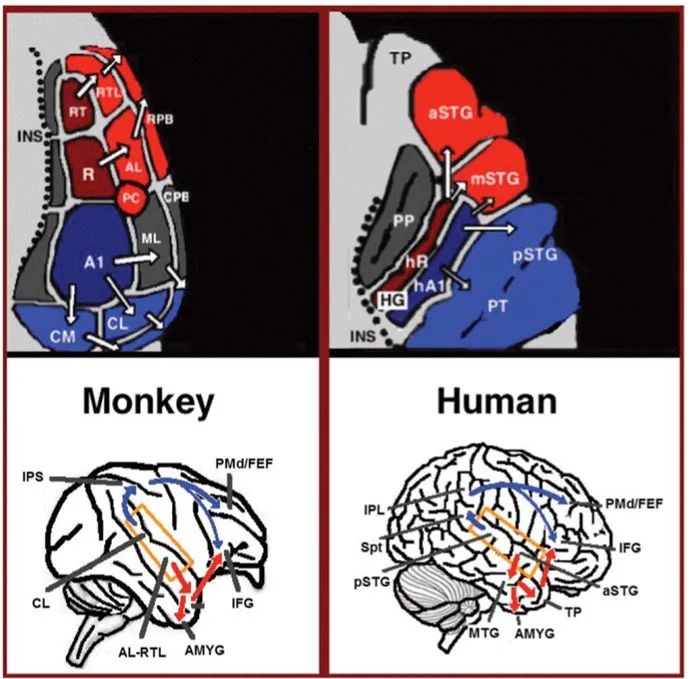
▷ Bidirectional connections between the auditory cortex and the frontal lobe in monkeys and humans. Source: Poliva O. From where to what: a neuroanatomically based evolutionary model of the emergence of speech in humans. F1000Res. 2015;4:67. Published 2015 Mar 13. doi:10.12688/f1000research.6175.3
Animal experiments related to language evolution are typically analyzed in terms of symbolic rules, grammar, and complex sequential discrimination. The concept of the “sequence bottleneck” provides a fresh perspective on the origins of language by highlighting the evolutionary constraints on animals’ sequential processing abilities. John Lind has noted that the ever-increasing body of research in the field of cognition—evidenced by the rising number of papers published annually—has made it increasingly challenging to integrate diverse perspectives. Researchers often focus on their specialized subfields, resulting in limited interdisciplinary communication and collaboration. In contrast, the limitations of animal memory systems provide important insights into the differences between human and animal behavioral patterns, language evolution, and learning models.

How Did Humans Achieve an “Evolutionary Leap”?
Human language and intelligence are unique, even though animals exhibit certain human-like traits in some areas. For example, chimpanzees display complex social behaviors, and orangutans use tools—both of which reflect aspects of cooperation and competition. Dolphins, on the other hand, possess complex “grammatical” systems for communication and cooperation. Many bird species also demonstrate remarkable abilities in learning and mimicry; for instance, the Chestnut-breasted Bunting can rapidly acquire new songs. However, compared with human capabilities, these traits lack the cumulative, abstract, and extensible qualities found in human language and intelligence.

▷ “Rise of the Planet of the Apes”: Why Did It Only Occur in Science Fiction? Source: Gooffon
Throughout human evolution, a series of pivotal turning points set us apart from other primates. These milestones include the use of complex tools such as fire, the production and use of stone tools, the emergence of communal living and the transmission of technology, and the inheritance of tribal culture, among others. In human evolution, language is not merely a tool for communication but also serves as the foundation for abstract thought and social collaboration. Human culture has grown progressively more complex and refined through generational transmission—an achievement that animals simply cannot match.
The emergence of linguistic abilities and changes in brain structure likely reinforced each other, while the Agricultural Revolution, which began around ten thousand years ago, accelerated genetic adaptations to dietary changes (such as the evolution of lactose tolerance genes). This co-evolutionary mechanism is the core driving force that distinguishes humans from other animals. In essence, the bidirectional interplay between genes and culture has shaped human evolution.
Over the course of approximately 200,000 years of Homo sapiens’ history, our uniqueness stems from the integration of language, culture, and social structure rather than from a simple continuation of traits. Are human cognitive and behavioral abilities the result of quantitative evolution (the “continuity hypothesis”) or of a series of qualitative leaps (the “discontinuity hypothesis”)? Does culture hold equal importance to biological evolution? Have current studies underestimated the intelligence and behavioral complexity of animals? In examining the uniqueness of human intelligence, at least two Swedish scholars have sought to counterbalance the bias toward human exceptionalism by acknowledging that animals also possess distinct cognitive abilities.

The Prophetic Vision of Science Fiction
Although some novels do not explicitly mention the concept of the sequence bottleneck, their core ideas are analogous to it. For instance, many of these works explore the complexity of language in relation to the evolution of human intelligence, the limits of human cognitive capacity, and comparisons between human and machine intelligence.
For example, in The Three-Body Problem, the “Sophons Project” involves the creation of artificial intelligence probes called “sophons” from subatomic particles. These sophons can monitor Earth’s scientific research in real time and impede human technological progress by interfering with particle experiments. Essentially, this project exploits the limitations of human information processing. By manipulating the flow of crucial information, the sophons create a “bottleneck” in scientific exploration that prevents humans from overcoming specific cognitive and technological constraints.
This bears a striking resemblance to the concept of the sequence bottleneck. Whether it pertains to the cognitive limitations of animals in natural environments or to the technological stagnation experienced by humans under conditions of high-dimensional interference, the underlying idea is clear: limitations in information processing have a fundamental impact on the development of intelligence.

▷ The Three-Body Problem Poster. Source: TV series of the same name
Other works, such as Charlie Stross’s Embassytown, Neal Stephenson’s Snow Crash, Arthur C. Clarke’s Childhood’s End, and Adolfo Casares’s The Invention of Morel, also engage with cutting-edge scientific issues related to language, intelligence, and cognition. In the future literary landscape, this theme may inspire even richer imaginations and further exploration.

Afterword: The Endless Frontier
Through pivotal evolutionary transitions, humans have emerged as a unique species on Earth. In addition to the remarkable process of biological evolution, culture, language, and social organization have played significant roles in shaping our development. This field still contains many unsolved mysteries—for example, the neural basis of the sequence bottleneck, the limits of animal intelligence, and the nature of human language. Current advances in neuroimaging and gene-editing technologies are facilitating further exploration into the neural and genetic mechanisms underlying the sequence bottleneck.
At present, research in cognitive science, neuroscience, and evolutionary biology has yielded numerous significant findings in the study of animal intelligence and language. These studies have not only shed light on whether animals possess language capabilities and clarified the similarities and differences between animal and human cognition, but they have also advanced our understanding of the evolutionary mechanisms underpinning human intelligence. Moreover, elucidating the concept of the sequence bottleneck holds profound implications for artificial intelligence design. For instance, by simulating the human brain’s sequential processing mechanisms, it may be possible to enhance natural language processing technology. Through interdisciplinary collaboration, we may eventually decode the mysteries of language, intelligence, and life in a more comprehensive manner.
References:
[1] Miller EK, Cohen JD. An integrative theory of prefrontal cortex function. Annu Rev Neurosci. 2001;24:167-202. doi:10.1146/annurev.neuro.24.1.167
[2] Lind J, Jon-And A. A sequence bottleneck for animal intelligence and language?. Trends Cogn Sci. Published online November 7, 2024. doi:10.1016/j.tics.2024.10.009
Tulving E. Episodic memory: from mind to brain. Annu Rev Psychol. 2002;53:1-25. doi:10.1146/annurev.psych.53.100901.135114